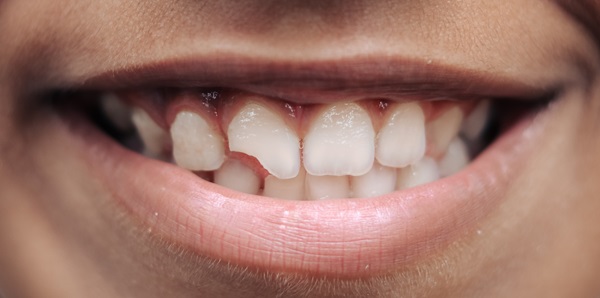Restorative Options for a Front Broken Tooth

A broken tooth is a common dental issue that fills most people with dread, especially when the crack is near the front of the mouth. Front teeth fractures are quite common among children, teenagers, and young adults. Fortunately, a dentist can recommend various repair or replacement options for damaged front teeth to help patients resume smiling.
What causes teeth to break?
Teeth are naturally durable, but various circumstances can cause them to weaken to the point of cracking, chipping, or breaking, including:
- Biting on hard foods or objects
- Sustaining blunt trauma while playing sports
- Eating and drinking habits that break down the protective outer enamel layer
- Tripping, falling, and other accidents
- Leaving cavities untreated and losing fillings
- Grinding and clenching teeth
Front teeth are particularly vulnerable and can sustain damage that impacts the overall oral integrity. Sometimes, a fractured tooth is not so obvious, especially if the tooth is not visible when smiling. The most common signs of a broken tooth or teeth are pain, swelling, bleeding, and discoloration. However, the most obvious sign in the front teeth is a gap between the patient's gum and the tooth's edge. The patient may also notice loose teeth or bone fragments in their mouth that should not be there.
What restoration options can address a broken tooth?
After breaking a front tooth, patients who visit a dental provider promptly can minimize complications, including infection. However, seeking treatment should still be the top priority for those who are not experiencing any immediate discomfort or pain-related symptoms. In addition, a dentist can determine one of the following restoration options depending on the extent of the damage.
Root canal therapy
A broken tooth can lead to infection by exposing the underlying pulp to oral bacteria. When that happens, a dentist must begin the restoration process with root canal therapy. The treatment involves removing the infected nerves and tissue from the channels within the root through a later sealed opening to prevent new infections. Once we restore the tooth's health, its appearance can be fixed.
Dental crown
A dentist may use a cap or crown on a broken tooth that requires root canal treatment or is missing a significant portion of its natural crown above the gumline. Crowning involves grinding and smoothing what remains of the visible natural incisor to ensure that the prosthetic cap fits appropriately. The replacement cover typically consists of porcelain, which has a natural appearance that a dentist can color match to surrounding teeth.
Dental bonding
Bonding repairs minor chips and damage to front teeth. First, the tooth is sanded to achieve the rough surface necessary to hold an adhesive that attaches to the resin bonding material. Then, the dentist molds the resin into the desired shape and secures it in place with an ultraviolet light.
Dental veneer
Dental veneers fit over chipped or cracked front teeth to mask imperfections. Veneer placement starts with grinding down the tooth to ensure the thin shell overlay does not protrude further than the surrounding teeth. Next, a lab technician prepares the shell to achieve precise color and proportions. In the final step, the dentist permanently adheres the veneer to the tooth with a bonding agent.
Dental implant
Sometimes a tooth can crack below the gum line, resulting in a severe infection. A dentist must pull it and install a titanium implant that replaces the natural root. A porcelain crown attaches to an abutment on the implant that extends through the gum. Implants are the most invasive and time-consuming option for restoring a broken tooth, requiring multiple treatment stages.
The best time to restore a broken tooth
Regardless of the cause of a broken front tooth, the dentist must address this problem immediately to prevent further underlying damage. In addition, early intervention allows us to preserve as much of the patient's natural tooth structure as possible while avoiding decay in the future.
The dentist will decide which restorative option will be more effective for the patient after considering the cause of the break, the severity of the break, the patient's age, and the overall condition of their oral health.
Conclusion
In the end, you should know that there are many restoration options for you and any member of your family. A broken tooth near the front of the mouth can impact someone's appearance, oral health, dental function, and self-esteem. Our dentist can craft a plan to fix a newfound gap and restore your healthy smile. Unfortunately, there are no at-home quick fixes for a broken tooth, and the only way to prevent further and costly damage is by scheduling an appointment today.
Request an appointment here: https://somervilledentist.com or call Assembly Dental at (857) 300-5779 for an appointment in our Somerville office.
Check out what others are saying about our dental services on Yelp: What Should I Do If I Chip My Tooth in Somerville, MA.
Related Posts
A broken tooth can be a stressful and uncomfortable experience, requiring prompt attention to prevent further damage or complications. Whether caused by an accident, biting into something hard, or untreated decay, addressing a broken tooth quickly is crucial to maintaining oral health. Understanding the steps to take after experiencing a broken tooth can help preserve…
A broken tooth is a common dental issue that can happen for many reasons, such as accidents, biting into something hard, or untreated tooth decay. Whether a dentist can save a broken tooth or needs to remove it depends on how severe the damage is and how quickly patients seek treatment. While modern dental techniques…
If you act fast enough, we may be able to restore the chipped tooth. If not, we still have options. Call us for details.No matter the extent of the chip, it is crucial to call us right away in the event of a chipped tooth. By acting fast, we can help to either restore the…
Dental crowns are often costly and require that a dentist remove a significant amount of the tooth's structure to place them. Read on to learn about dental crown alternatives. Other treatment alternatives are sometimes available that are either less expensive or significantly less invasive. Dental crowns are frequently used to restore severely damaged teeth.The following…






